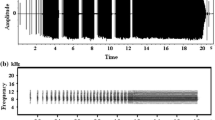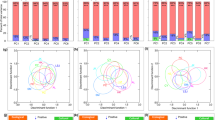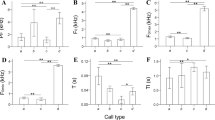Abstract
Islands are natural laboratories for the study of speciation mechanisms, such as allopatric diversification and adaptive radiation. Our study focuses on the long northern arm of Sulawesi, which is the home of three known tarsier species: Tarsius spectrumgurskyae, T. supriatnai, and T. wallacei. The precise location of the boundaries was unknown, but a biogeographic hypothesis for the island made predictions as to where they would be. We used acoustic surveys to locate tarsier faunal boundaries and contact zones along both coasts of the northern peninsula. We analyzed the duet parameters of 82 tarsier duet calls from 49 locations. Our results revealed four acoustic groups: Manado (T. spectrumgurskyae), Gorontalo (T. supriatnai), Tinombo (T. wallacei), and a previously unknown group between Manado and Gorontalo forms, which we call the Labanu form. Our results on the south coast revealed faunal boundaries associated with geographic barriers. Along the north coast, faunal boundaries were not associated with geographic barriers. Intensive survey efforts identified heterospecific groups in a single spectrogram. The study region has undergone significant deforestation, particularly the region where the Labanu form is found. We suspect this form to be a stable hybrid, formed by secondary contact between T. spectrumgurskyae and T. supriatnai. We estimate that the Labanu form would be Red Listed as Endangered should it be determined to be a new species. Follow-up genetic studies are urgent to validate the taxonomic status of the new acoustic form before it becomes extinct due to habitat loss.





Similar content being viewed by others
References
Arini, D. I. D., Christita, M., & Kinho, J. (2019). the Macrofungi Diversity and Their Potential Utilization in Tangale Nature Reserve Gorontalo Province. Berita Biologi, 18(1). https://doi.org/10.14203/beritabiologi.v18i1.3379.
Brandon-Jones, D., Eudey, A. A., Geissmann, T., Groves, C. P., Melnick, D. J., Morales, J. C., et al. (2004). Asian primate classification. International Journal of Primatology, 25(1), 97–164.
Burton, J. A., & Nietsch, A. (2010). Geographical variation in duet songs of Sulawesi Tarsiers: Evidence for new cryptic species in south and southeast Sulawesi. International Journal of Primatology, 31(6), 1123–1146. https://doi.org/10.1007/s10764-010-9449-8
Bynum, E. L., Bynum, D. Z., & Supriatna, J. (1997). Confirmation and location of the hybrid zone between wild populations of Macaca tonkeana and Macaca hecki in Central Sulawesi, Indonesia. American Journal of Primatology, 43(3), 181–209.
Cannon, C. H., Summers, M., Harting, J. R., & Kessler, P. J. A. (2007). Developing conservation priorities based on forest type, condition, and threats in a poorly known ecoregion: Sulawesi, Indonesia. Biotropica, 39(6), 747–759. https://doi.org/10.1111/j.1744-7429.2007.00323.x.
Ciani, A. C., Stanyon, R., Scheffrahn, W., & Sampurno, B. (1989). Evidence of gene flow between Sulawesi macaques. American Journal of Primatology, 17(4), 257–270.
Clink, D. J., Tasirin, J. S., & Klinck, H. (2020). Vocal individuality and rhythm in male and female duet contributions of a nonhuman primate. Current Zoology, 66(2), 173–186. https://doi.org/10.1093/cz/zoz035
Conenna, I., Rocha, R., Russo, D., & Cabeza, M. (2017). Insular bats and research effort: A review of global patterns and priorities. Mammal Review, 47(3), 169–182.
Demos, T. C., Achmadi, A. S., Giarla, T. C., Handika, H., Rowe, K. C., & Esselstyn, J. A. (2016). Local endemism and within-island diversification of shrews illustrate the importance of speciation in building Sundaland mammal diversity. Molecular Ecology, 25(20), 5158–5173.
Dinerstein, E., Olson, D., Joshi, A., Vynne, C., Burgess, N. D., Wikramanayake, E., et al. (2017). An ecoregion-based approach to protecting half the terrestrial realm. BioScience, 67(6), 534–545.
Driller, C. (2013). The eventful history of a “living fossil” Phylogeny and phylogeography of Sulawesi tarsiers. Johannes Gutenberg-Universität. Retrieved from https://doi.org/10.25358/openscience-849.
Driller, C., Merker, S., Perwitasari-Farajallah, D., Sinaga, W., Anggraeni, N., & Zischler, H. (2015). Stop and go - Waves of tarsier dispersal mirror the genesis of Sulawesi island. PLoS ONE, 10(11), 1–20. https://doi.org/10.1371/journal.pone.0141212
Esselstyn, J. A., Achmadi, A. S., Handika, H., Swanson, M. T., Giarla, T. C., & Rowe, K. C. (2021). Fourteen New, Endemic Species of Shrew (Genus Crocidura) from Sulawesi Reveal a Spectacular Island Radiation. Bulletin of the American Museum of Natural History, 454(1), 1–108. https://doi.org/10.1206/0003-0090.454.1.1
Evans, B. J., Supriatna, J., & Melnick, D. J. (2001). Hybridization and population genetics of two macaque species in Sulawesi, Indonesia. Evolution, 55(8), 1686–1702. https://doi.org/10.1111/j.0014-3820.2001.tb00688.x
Evans, B. J., Supriatna, J., Andayani, N., & Melnick, D. J. (2003a). Diversification of Sulawesi macaque monkeys: Decoupled evolution of mitochondrial and autosomal DNA. Evolution, 57(8), 1931–1946. https://doi.org/10.1554/02-476
Evans, B. J., Supriatna, J., Andayani, N., Setiadi, M. J., Cannatella, D. C., & Melnick, D. O. N. J. (2003b). Monkeys and Toads Define Areas of Endemism on Sulawesi. Evolution, 57(6), 1436–1443.
Fooden, J. (1969). Taxonomy and evolution of monkeys of Celebes (Primates: Cercopithecidae). Bibl. Primatology, 10, 1–148.
Frantz, L. A. F., Rudzinski, A., Nugraha, A. M. S., Evin, A., Burton, J., Hulme-Beaman, A., et al. (2018). Synchronous diversification of sulawesi’s iconic artiodactyls driven by recent geological events. Proceedings of the Royal Society B: Biological Sciences, 285(1876). https://doi.org/10.1098/rspb.2017.2566.
Froehlich, J. W., & Supriatna, J. (1996). Secondary integration between Macaca maurus and M. tonkeana in South Sulawesi, and the species status of M. togeanus. In J. E. Fa. & D.G. Lindburg (Eds.), Evolution and ecology of macaque societies (pp. 43–70). Cambridge, UK: Cambridge University Press.
Giarla, T. C., Maher, S. P., Achmadi, A. S., Moore, M. K., Swanson, M. T., Rowe, K. C., & Esselstyn, J. A. (2018). Isolation by marine barriers and climate explain areas of endemism in an island rodent. Journal of Biogeography, 45(9), 2053–2066.
Hall, R. (1996). Reconstructing Cenozoic SE Asia. Geological Society Special Publication, 106(106), 153–184. https://doi.org/10.1144/GSL.SP.1996.106.01.11
Hall, R. (2001). Cenozoic reconstructions of SE Asia and the SW Pacific: Changing patterns of land and sea. In I. Metcalfe, J. M. B. Smith, M. Morwood, & I. D. Davidson (Eds.), Faunal and Floral Migrations and Evolution in SE Asia-Australasia (pp. 35–56). Lisse: Balkema.
Hansen, A. M. C., Potapov, P. V., Moore, R., Hancher, M., Turubanova, S. A., Thau, D., et al. (2013). High-Resolution Global Maps of 21st-century Forest Cover Change. Science, 342(6160), 850–853.
Jenkins, C. N., Pimm, S. L., & Joppa, L. N. (2013). Global patterns of terrestrial vertebrate diversity and conservation. Proceedings of the National Academy of Sciences, 110(28), E2602–E2610.
Johnson, C. L., Hilser, H., Andayani, N., Hunowu, I., Linkie, M., Patandung, A., et al. (2019). Camera Traps Clarify the Distribution Boundary between the Crested Black Macaque (Macaca nigra) and Gorontalo Macaque (Macaca nigrescens) in North Sulawesi. International Journal of Primatology, 40(2), 162–166. https://doi.org/10.1007/s10764-019-00082-1
Jouzel, J., Masson-Delmotte, V., Cattani, O., Dreyfus, G., Falourd, S., Hoffmann, G., et al. (2007). Orbital and millennial Antarctic climate variability over the past 800,000 years. Science, 317(5839), 793–796.
Kennerley, R. J., Lacher, T. E., Jr., Hudson, M. A., Long, B., McCay, S. D., Roach, N. S., et al. (2021). Global patterns of extinction risk and conservation needs for Rodentia and Eulipotyphla. Diversity and Distributions, 27(9), 1792–1806.
Kulander, O. C. (2018). Whence and Whither: Acoustic Variability and Biogeography of Tarsiers in North Sulawesi. Portland State University.
Lee, R., Riley, E., Sangermano, F., Cannon, C. & Shekelle, M. (2020). Macaca nigrescens. The IUCN Red List of Threatened Species 2020: e.T12568A17948400. https://doi.org/10.2305/IUCN.UK.2020-3.RLTS.T12568A17948400.en. Accessed 31 May 2023.
Lohman, D. J., de Bruyn, M., Page, T., von Rintelen, K., Hall, R., Ng, P. K. L., et al. (2011). Biogeography of the Indo-Australian archipelago. Annual Review of Ecology, Evolution and Systematics, 42, 205–226.
Losos, J. B., & Ricklefs, R. E. (2009). Adaptation and diversification on islands. Nature, 457(7231), 830–836.
MacKinnon, J., & MacKinnon, K. (1980). The behavior of wild spectral tarsiers. International Journal of Primatology, 1(4), 361–379. https://doi.org/10.1007/BF02692280
Merker, S., & Groves, C. P. (2006). Tarsius lariang: A new primate species from Western Central Sulawesi. International Journal of Primatology, 27(2), 465–485. https://doi.org/10.1007/s10764-006-9038-z
Merker, S., Driller, C., Perwitasari-Farajallah, D., Pamungkas, J., & Zischler, H. (2009). Elucidating geological and biological processes underlying the diversification of Sulawesi tarsiers. Proceedings of the National Academy of Sciences of the United States of America, 106(21), 8459–8464. https://doi.org/10.1073/pnas.0900319106
Merker, S., Driller, C., Dahruddin, H., Wirdateti, Sinaga, W., Perwitasari-Farajallah, D., & Shekelle, M. (2010). Tarsius wallacei: A New Tarsier Species from Central Sulawesi Occupies a Discontinuous Range. International Journal of Primatology, 31(6), 1107–1122. https://doi.org/10.1007/s10764-010-9452-0.
Myers, N., Mittermeier, R. A., Mittermeier, C. G., Da Fonseca, G. A. B., & Kent, J. (2000). Biodiversity hotspots for conservation priorities. Nature, 403(6772), 853–858.
Niemitz C. (1984). Vocal communication of two tarsier species (Tarsius bancanus and Tarsius spectrum). In Niemitz, C. (Ed.), Biology of tarsiers (pp. 129–141). Stuttgart, Germany: Gustav Fischer Verlag.
Niemitz, C., Niestch, A., Warter, S., & Rumpler, Y. (1991). Tarsius dianae: A New Primate Species form Central Sulawesi (Indonesia). Folia Primatologica, 56, 105–116.
Nietsch, A., & Niemitz, C. (1993). Diversity of Sulawesi tarsiers. Deutsche Gesellschaft Fur Saugetierkunde, 67, 45–46.
Nietsch, A., & Kopp, M. L. (1998). Role of vocalization in species differentiation of Sulawesi tarsiers. Folia Primatologica, 69(SUPPL. 1), 371–378. https://doi.org/10.1159/000052725
Nietsch, A. (1999). Duet vocalizations among different populations of Sulawesi tarsiers. International Journal of Primatology, 20(4), 567–583. https://doi.org/10.1023/A:1020342807709
Nugraha, A. M. S., & Hall, R. (2018). Late Cenozoic palaeogeography of Sulawesi, Indonesia. Palaeogeography, Palaeoclimatology, Palaeoecology, 490(November 2017), 191–209. https://doi.org/10.1016/j.palaeo.2017.10.033.
Olson, D. M., & Dinerstein, E. (2002). The Global 200: Priority ecoregions for global conservation. Annals of the Missouri Botanical Garden, 89, 199–224.
Pusparini, W., Cahyana, A., Grantham, H. S., Maxwell, S., Soto-Navarro, C., & Macdonald, D. W. (2023). A bolder conservation future for Indonesia by prioritising biodiversity, carbon and unique ecosystems in Sulawesi. Scientific Reports, 13(1), 1–13.
Rheindt, F. E., Prawiradilaga, D. M., Ashari, H., Suparno, Gwee, C. Y., Lee, G. W. X., et al. (2020). A lost world in Wallacea: description of a montane archipelagic avifauna. Science, 367(6474), 167–170.
Schuler, M. (2017). Improving lives and livelihood in Sulawesi through the ecology, evolution, and conservation of tarsiers [Internship report]. Strasbourg, Alsace: University of Strasbourg.
Setiadi, M. I., McGuire, J. A., Brown, R. M., Zubairi, M., Iskandar, D. T., Andayani, N., et al. (2011). Adaptive radiation and ecological opportunity in Sulawesi and Philippine fanged frog (Limnonectes) communities. American Naturalist, 178(2), 221–240. https://doi.org/10.1086/660830
Shekelle, M. (2003). Taxonomy and biogeography of Eastern Tarsius. PhD Dissertation, Washington University, Saint Louis, MO.
Shekelle, M. (2008). Distribution of tarsier acoustic forms, North and Central Sulawesi: With notes on the primary taxonomy of Sulawesi’s tarsiers. In Primates of the oriental night (pp. 35–50). Indonesia Institute of Sciences, Research Center for Biology.
Shekelle, M. (2020). Tarsius spectrumgurskyae. The IUCN Red List of Threatened Species 2020: e.T162336422A162336580. https://doi.org/10.2305/IUCN.UK.2020-3.RLTS.T162336422A162336580.en. Accessed 31 May 2023.
Shekelle, M. (2022). Tarsius supriatnai (errata version). The IUCN Red List of Threatened Species 2020: e.T162336881A220971513. https://doi.org/10.2305/IUCN.UK.2020-3.RLTS.T162336881A220971513.en. Accessed 31 May 2023.
Shekelle, M., Leksono, S. M., Ichwan, L. L. S., & Masala, Y. (1997). The natural history of the tarsiers of North and Central Sulawesi. Sulawesi Primate Newsletter, 4(January 1997), 4–11.
Shekelle, M., & Leksono, S. M. (2004). Strategi Konservasi di Pulau Sulawesi dengan Menggunakan Tarsius sebagai Flagship Species. Biota, IX(1), 1–10.
Shekelle, M., Groves, C., Merker, S., & Supriatna, J. (2008a). Tarsius tumpara: A New Tarsier Species from Siau Island, North Sulawesi. Primate Conservation, 23(1), 55–64. https://doi.org/10.1896/052.023.0106
Shekelle, M., Morales, J. C., Niemitz, C., Ichwan, L. L., & Melnick, D. (2008b). Distribution of tarsier haplotypes for some parts of northern and central Sulawesi. In Primates of the oriental night (pp. 51–69). Indonesia Institute of Sciences, Research Center for Biology.
Shekelle, M., Meier, R., Wahyu, I., Wirdateti, & Ting, N. (2010). Molecular Phylogenetics and Chronometrics of Tarsiidae Based on 12S mtDNA Haplotypes: Evidence for Miocene Origins of Crown Tarsiers and Numerous Species within the Sulawesian Clade. International Journal of Primatology, 31(6), 1083–1106. https://doi.org/10.1007/s10764-010-9457-8.
Shekelle, M., Groves, C. P., Maryanto, I., & Mittermeier, R. A. (2017). Two new tarsier species (Tarsiidae, Primates) and the biogeography of Sulawesi, Indonesia. Primate Conservation, 31(1), 61–70.
Shekelle, M., Groves, C. P., Maryanto, I., Mittermeier, R. A., Salim, A., & Springer, M. S. (2019). A New Tarsier Species from the Togean Islands of Central Sulawesi, Indonesia, with References to Wallacea and Conservation on Sulawesi. Primate Conservation, 33(33), 65–73.
Stelbrink, B., Albrecht, C., Hall, R., & von Rintelen, T. (2012). The biogeography of sulawesi revisited: Is there evidence for a vicariant origin of taxa on Wallace’s “anomalous island”? Evolution, 66(7), 2252–2271. https://doi.org/10.1111/j.1558-5646.2012.01588.x
Struebig, M. J., Aninta, S. G., Beger, M., Bani, A., Barus, H., Brace, S., et al. (2022). Safeguarding Imperiled Biodiversity and Evolutionary Processes in the Wallacea Center of Endemism. BioScience, biac085. https://doi.org/10.1093/biosci/biac085.
Supriatna, J. (1996). Gene Flow of the two hybridized Sulawesi Macaques: Macaca tonkeana and Macaca maurus. In: Kitchener, D.J., Suyanto, A. (Eds.), Proceedings of the First International Conference on Eastern Indonesia-Australian Vertebrate Fauna (pp. 22–26). Indonesian Institute of Science.
Supriatna, J., Shekelle, M., Fuad, H. A. H., Winarni, N. L., Dwiyahreni, A. A., Farid, M., et al. (2020). Deforestation on the Indonesian island of Sulawesi and the loss of primate habitat. Global Ecology and Conservation, 24, e01205. https://doi.org/10.1016/j.gecco.2020.e01205.
Toussaint, E. F. A., Hall, R., Monaghan, M. T., Sagata, K., Ibalim, S., Shaverdo, H. V., et al. (2014). The towering orogeny of New Guinea as a trigger for arthropod megadiversity. Nature Communications, 5(1), 1–10.
Voigt, M., Supriatna, J., Deere, N. J., Kastanya, A., Mitchell, S. L., Rosa, I. M. D., et al. (2021). Emerging threats from deforestation and forest fragmentation in the Wallacea centre of endemism. Environmental Research Letters, 16(9). https://doi.org/10.1088/1748-9326/ac15cd.
Whitten, T., & Henderson, G. (2012). Ecology of Sulawesi. Tuttle Publishing.
Wilson, E. O., & MacArthur, R. H. (1967). The Theory Of Island Biogeography (Vol. 1). Princeton University Press.
Wilson, K. A., McBride, M. F., Bode, M., & Possingham, H. P. (2006). Prioritizing global conservation efforts. Nature, 440(7082), 337–340.
Yan, X., Terai, Y., Widayati, K. A., Itoigawa, A., Purba, L. H. P. S., Fahri, F., et al. (2022). Functional divergence of the pigmentation gene melanocortin-1 receptor (MC1R) in six endemic Macaca species on Sulawesi Island. Scientific Reports, 12(1), 7593. https://doi.org/10.1038/s41598-022-11681-z
Yi, Y., Shekelle, M., Jang, Y., & Choe, J. C. (2015). Discriminating tarsier acoustic forms from Sulawesi’s northern peninsula. The 84th Annual Meeting of the American Association of Physical Anthropologists. https://meeting.physanth.org/program/2015/session42/yi-2015-discriminating-tarsier-acoustic-forms-from-sulawesis-northern-peninsula.html. Accessed 13 January 2022.
Acknowledgements
This study was supported by PUTI-Doctoral 2020 Universitas Indonesia with contract number NKB-638/UN2.RST/HKP.05.00/2020 awarded to Jatna Supriatna. The authors express their appreciation to the editor and reviewers for their contributions to the improvement of this paper. The authors also thank the Ministry of Environment and Forestry of the Republic of Indonesia for the research permit and the Ministry of Education, Culture, Research, and Technology for funding the first author's graduate scholarship BPPDN (Beasiswa Pendidikan Pasca Sarjana Dalam Negeri).
Author information
Authors and Affiliations
Contributions
The study was developed, designed, and coordinated by ZZ, JS, A, and MS. ZZ and MS were in charge of data collection. ZZ performed statistical analysis. The manuscript was interpreted and written by ZZ and MS and edited by JS and A. All authors granted their final clearance for publication and agreed to be held responsible for the work they did.
Corresponding author
Ethics declarations
Competing interest
The authors declare no competing interests.
Additional information
Handling Editor: Joanna (Jo) M. Setchell
Supplementary Information
Below is the link to the electronic supplementary material.
Rights and permissions
Springer Nature or its licensor (e.g. a society or other partner) holds exclusive rights to this article under a publishing agreement with the author(s) or other rightsholder(s); author self-archiving of the accepted manuscript version of this article is solely governed by the terms of such publishing agreement and applicable law.
About this article
Cite this article
Zakaria, Z., Supriatna, J., Abinawanto, A. et al. Quantitative Analysis of Tarsier Duet Calls from Field Surveys Reveals a New Acoustic Form in Gorontalo (Indonesia). Int J Primatol 44, 823–846 (2023). https://doi.org/10.1007/s10764-023-00369-4
Received:
Accepted:
Published:
Issue Date:
DOI: https://doi.org/10.1007/s10764-023-00369-4




